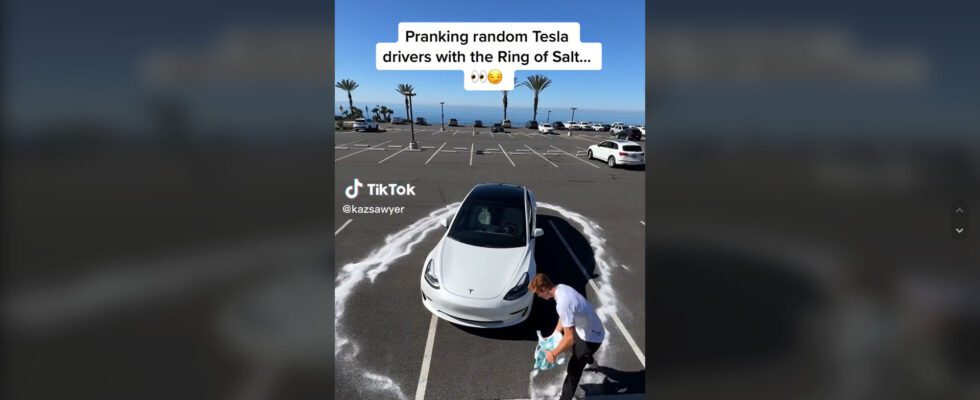A new trend appears on social networks, since February 26, 2023. The idea is to trap Teslas in the middle of a circle of salt to prevent them from leaving. True or false ?
Social networks are full of brilliant ideas, as perfectly stupid. Several videos are starting to go viral around a prank carried out to trap drivers of Tesla vehicles. Published on February 26, 2023, Kaz Sawyer’s videos on this subject have accumulated more than 73 million views, divided between YouTube and TikTok, as of March 10. The principle is to spread a circle of salt all around the car so that autonomous driving cannot work.
A circle of salt to trap the automotive demon of self-driving? It seems ridiculous presented like this, but nevertheless inspires a lot some content creators. Do not waste several kilos of salt to reproduce the video, you will waste a lot of energy for nothing. We explain why.
Why doesn’t the salt joke work on a Tesla?
The whole principle of farce is based on the idea thata self-driving car cannot break traffic rules. It therefore cannot, in theory, cross a white line drawn on the ground.
By encircling the car with salt thick enough to mimic continuous road markings, the pranksters hope to block the Teslas. It is not so, and it was frankly predictable. Already, because a large proportion of Tesla drivers simply drive their Tesla. They thus do not engage the autonomous driving capabilities, of the Full Self-Driving type, to maneuver in order to get out of a parking space. We can observe it elsewhere in the videos, the “trapped” driver engages the forward (or reverse) gear and accelerates without being blocked or slowed down by the salt.
Even if the driver of a Tesla would activate the autonomous driving system FSD, before leaving his parking space, the result would most likely be identical. Who can imagine that an irregular line of salt, sand or snow blocks a vehicle by tricking the system? The same goes for parking maneuvers launched from the Tesla app. All of this just wastes salt and possibly kicks the car into sentry mode.
It would be much more interesting to renew the experience by painting lines, using the same characteristics as the official floor markings. Then, to observe the reaction of autonomous driving to this very human “case of conscience” for an AI.
An idea already exploited in 2017
If you’re wondering how this strange idea crossed the minds of these influencers, you definitely have to go back a few years. This Techcrunch article from 2017 features the work of an English artist named James Bridle. The video dubbed “self-driving car trap 001” asks not what self-driving cars can do, but rather what they can’t. This was also the case with our experimentation with an autonomous vehicle from Nissan on the streets of London.
Behind this first video of the artist, there is no result, no answer, indicating if the trap can really work. We can imagine that, since then, the idea has made its way and turned into a joke, taken up and currently broadcast on social networks.
Salt makes it easy to reproduce the staging, and multiply the covers and other variations that will certainly flourish on YouTube and TikTok in the coming months.
The data transmitted through this form is intended for PressTiC Numerama, in its capacity as data controller. These data are processed with your consent for the purpose of sending you by e-mail news and information relating to the editorial content published on this site. You can oppose these e-mails at any time by clicking on the unsubscribe links present in each of them. For more information, you can consult our entire personal data processing policy.
You have a right of access, rectification, erasure, limitation, portability and opposition for legitimate reasons to personal data concerning you. To exercise one of these rights, please make your request via our dedicated rights exercise request form.
Finally, a real substantive subject for autonomous cars
Behind the bad joke, which ended in a masterful failure, still hide real questions. How would an autonomous car behave in an inextricable situation? Can the vehicle override the traffic rules to get out of a difficulty hindering its circulation?
This is in fact all the work currently being done by the teams working on autonomous driving and AI. The way in which the autonomous vehicle analyzes the different markings on the ground or their absence is part of the basics of the technology. This is also what may define in the future what will be the best technologies for autonomous driving: Lidar or only cameras like Tesla? Which system, in the present case, is best designed to distinguish a legitimate marking on the ground from a pile of salt or snow that can be overridden? In this case, everyone must be able to tell the difference.
If you liked this article, you will like the following ones: do not miss them by subscribing to Numerama on Google News.
